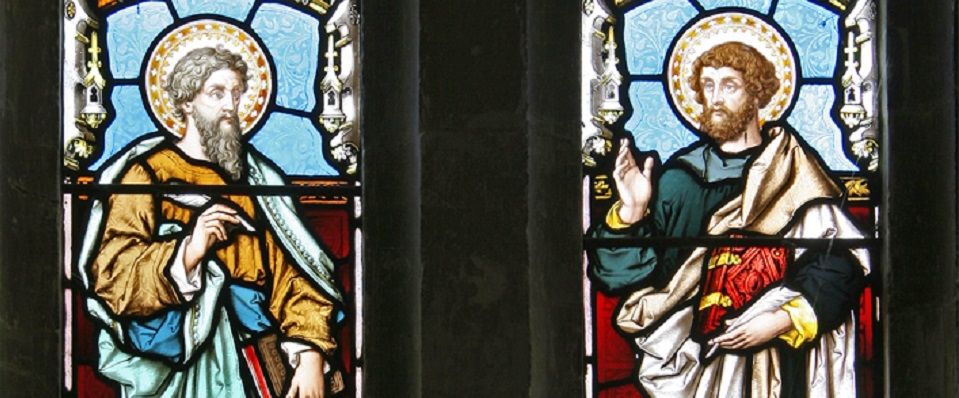Reflections on Fr Denis McBride’s talk given 7th March 2020
Almost exactly a year before (9th March 2019), St Stephen’s had a visit from acclaimed author and theologian Fr Denis McBride talking about the passion narratives in the four Gospels and how they agree and differ. This time, around 50 people gathered (not realising how such gatherings would very soon be no longer permitted for a while) in the parish hall for another inspiring talk.
Fr Denis began by challenging us to think about how we would describe Jesus to someone who had no knowledge of him; where would we begin? Different answers were called out: birth, resurrection, miracles, death…… And so we arrived at the reason why the four Gospels all begin in quite different ways.
We were then asked to think about our own story and how we would describe it to others, getting us to think about the fate of foundlings, abandoned by their parents, who know nothing of their origins.
Mark’s is the shortest of the four Gospels and is considered to have been written first. He begins by introducing us to John the Baptist, describing how people were leaving the sacred space of the temple and going out into the wilderness to follow John. Fr Denis compared this to today’s exodus of people from the Church, finding others to follow. When Jesus is baptised, the focus moves from John to the Holy Spirit doing the baptising. After his baptism Jesus’s life changes dramatically. Before that his life was dominated by family and religion. After that, the focus of his life was kingdom and God.
Jesus wasn’t accepted by the people of Nazareth because they saw him as the carpenter’s son. Even his family thought he was “out of his mind” (3:21). When told his mother and brothers were outside (3:31-35) Jesus redefines his family, pointing at the crowd sitting around him. The disciples started out as family men, mostly fishermen. Jesus challenged them to change direction, promising them a new identity as “fishers of people”. Mark is tough on the family and disciples, keeping them at a low level in line with the fragility of human beings.
One point that I think came as a surprise to a number of us was that Mark wasn’t read in the Catholic Church until after Vatican II in the 1960s, Matthew’s Gospel being seen as preferable before that time. The latter was used as a teaching Gospel for post Baptismal instruction.
After lunch Fr Denis turned his attention to Matthew. In 70 AD the temple in Jerusalem was destroyed, leaving Jewish Christians without a religious home. After that you had to be either a Jew or a Christian. Matthew is the only evangelist to mention “Church” built on Peter’s profession of faith (16:16-18). Matthew’s Church is built on the exiled Jews and the growing number of Gentiles who believe in Jesus. These two groups don’t share the same ancestry, so Matthew needs an ancestor who is neutral. He chooses Abraham who is the father of many nations, but not a Jew. He is both Jew and Gentile.
Matthew begins with the genealogy of Christ, a list we might be tempted to skip, but it is important to his readers. The list of Jesus’s ancestors includes four women, apart from his mother Mary who is a Jew. These four – Tamar, Rahab, Ruth and Uriah’s wife (Bathsheba) – are all Gentiles. The men provide a continuous Israelite descent whilst the women provide discontinuity. In the Wednesday morning Bible course some of us have been following, Bible scholar Jeff Cavins describes them as “shady ladies”. It is interesting to look up each one and read about them.
Matthew says very little about Mary and says more about Joseph. In his version Jesus is born in the house of Joseph, not a stable, but for some reason Luke’s version has been adopted down the centuries. The magi who visited the child Jesus were Gentiles from the east. When the Holy Family had to escape from Herod they were given hospitality by the Egyptians, and yet they were the traditional enemies of the Jews in the Old Testament. Matthew quotes scripture, especially Isaiah, accurately on a few occasions, showing his great knowledge.
In the rather strange passage to be found in chapter 15, Jesus eventually welcomes the Canaanite woman who requests that he cure her tormented daughter, asking him to give her the scraps that might be given to the dogs, though initially he seems to be suggesting he is there only for the lost sheep of Israel. Fr Denis concluded his inspiring day of 45-minute talks by comparing this incident to the church in Dover where the newcomers began to outnumber the original parishioners, who started to worry about being overrun by foreigners. But then they began to recognise what the newcomers were bringing: faith, colour, vitality…… Matthew’s dream, it seems, is one Church. And that is one great dream to have.
Fr Denis is due to come back to Welling, God willing, in October to speak about the Gospels of Luke and John. In the meantime, we can use this unexpected forced time at home during the Year of the Word to dust down our Bibles and have a good read.

